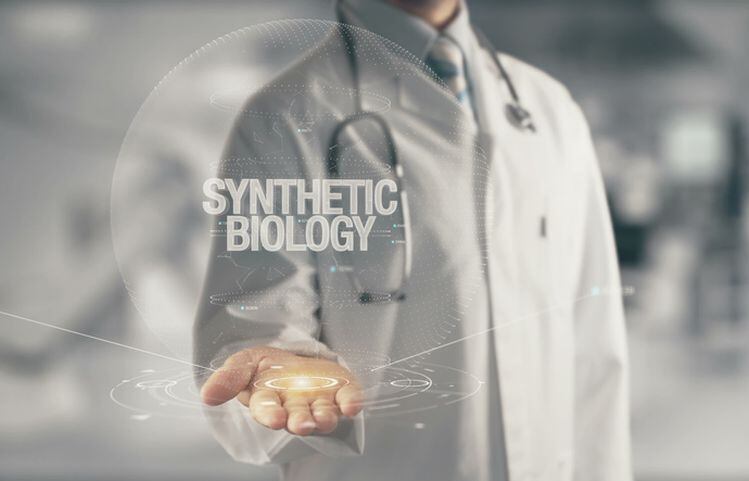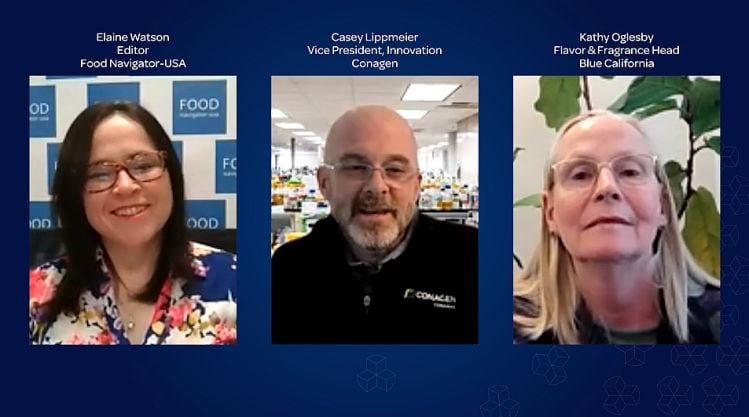But does it always make sense to extract flavors from plants if you can produce them more efficiently - and more sustainably – via microbial fermentation, and what might flavor production look like by the end of the 21st century?
What the flavor industry will look like in 2099 is anyone’s guess, “But if you look at the next 10 years, easily 30% of the flavor market could be made from biotech products," said Blue California’s head of flavors and fragrances Katy Oglesby during a panel moderated by FoodNavigator-USA at the virtual SynBioBeta food & agriculture conference this week.
"The time for biotechnology really is right now.”
Ultimately, “more than 100% of today’s market could be served by synthetic biology,” added fellow panelist Casey Lippmeier, VP innovation at synthetic biology specialist Conagen, which provides the science underpinning products it sells directly or via affiliates such as Blue California, Sweegen, and BASF.
To those wondering if Lippmeier’s math is a little off, he clarified: “Let me explain what I mean by that… The thing about synthetic biology, is that in addition to making all the wonderful molecules that exist in nature, you can make brand new ones too… and of course you do all the safety testing, but at the end of the day they could provide some very interesting flavor - and especially fragrance - solutions that currently don’t exist today, so that’s where the ‘more than 100%’ comes from.”
The sweet spot for synthetic biology in flavor production
In practice of course, said Lippmeier, it wouldn’t make sense to produce every flavor in a fermentation tank today, even though the technology is already there to create a large number of flavors this way: “To be clear, I wasn’t trying to suggest that we’ll displace all botanical extracts, I don’t see that.”
We’re probably not going to be using synthetic biology to make table sugar any time soon, for example, “because sugar cane does that about as efficiently as anything on the planet,” he observed. “Typically, our sweet spot is around things that are more difficult to source, that are seasonal, where there might be geo-political constraints impacting supply chains.”
‘We can’t meet the world’s demand for natural vanillin without biotech’
For some flavors, however, the economic and environmental rationale is already pretty clear, said Oglesby.
Right now, for example, 90% of the vanilla flavor used in foods and beverages is synthetic vanillin made from petrochemicals, because demand massively outstrips the supply of vanilla seed pods grown in Madagascar and a handful of other places.
However, vanillin can also be made ‘biologically’ from plant-based feedstocks via a fermentation process using a naturally occurring 'wild type' yeast, or from a genetically engineered yeast that feeds on sugar, which both deliver a different flavor experience to ‘artificial’ vanillin, and can be classified as natural flavors in the US.
The fact is, that “We can’t meet the world’s demand for natural vanillin without biotech,” claimed Oglesby.
“The question you have to ask is, is it possible to supply the world’s demand for natural flavors if we don’t apply biotechnology?”
More efficient, and more sustainable?
If you’re making flavors in fermentation tanks, said Lippmeier, you can make them to order, and you don’t have to worry about unpredictable weather, seasonality, political instability, supply chain interruptions, heavy metals and unexpected pesticide residues that plants suck up from the soil.
And utilizing a suite of microbes to convert sugars into target molecules, rather than devoting large tracts of agricultural land to grow plants that might only produce these molecules in microscopic quantities, is both more efficient, and more sustainable, he claimed.
“A lot of flavor and fragrance molecules only exist in trace, fractional amounts in plants, and if you were to harvest an entire field of peaches and squeeze out the gamma-Decalactone, which is responsible, primarily, for peach flavor, you would have diminishingly small amounts.
“When we make them by a microbial source in a fermentation or by using enzymes in a bio-conversion [where you start with a plant extract, say, and then use enzymes to convert it into a target molecule], we can scale these up to 250,000 liters, sometimes a million liters…. The nice thing about fermentation, is that it’s still biology, it really mimics what is happening in nature and in many cases, it uses the exact same enzymes, and so it gets you a formulation that in many cases cannot be reproduced with synthetic chemistry.”
He added: “The instructions for nature are in nature itself… we go to the natural source, determine what that genetic code is that encodes that particular enzyme or the enzymes of that biochemical pathway, and install them into one of our proprietary platform micro-organisms and start cranking out our favorite flavors and fragrances.”
Is a flavor made in a fermentation tank the same as a flavor extracted from a plant?
But can you match the complexity of plant extracts using fermentation/synthetic biology? Take vanilla extracts. The predominant flavor component is vanillin, but what about the other chemicals in vanilla that contribute all those complex smoky, spicy, botanical, sulfury, sweet and creamy notes?
According to Oglesby, it’s a question of deciding which components are important. Just because a natural flavor from a given plant might comprise 200+ components doesn’t mean all of them are needed to replicate it, she said.
“We don’t try to match a material’s composition, we try to match its performance… so we use an approach called molecular precision, where we try to identify the signature characterizing impact compounds… because not every component is important to the taste and flavor function.”
And while each of the key building blocks of a given flavor can be made via fermentation, said Lippmeier, you can also exclude those that are not contributing in a meaningful way to the flavor, or may even be undesirable: “In many cases, what actually exists in nature isn’t necessarily what tastes the best.”
As one example, he said, “Stevia leaf extract has a lot of bitter tastes that have slowed down its adoption… we have a proprietary technology for converting the molecules that convey those bitter flavors and turning them [using enzymes] into the better tasting sweet flavors [such as Reb M].”
And the technology is improving all the time, he added: “We’re doing bio-conversions that are multi-step, so not just using a single enzyme converting one thing to another, and it’s only going to get more complex as time goes on. Gene editing technologies are being very quickly adopted in our industry.
“One of the great things about synthetic biology is that we can make very targeted purified molecules when we want to, or we can make larger mixtures as well too.”
Is synthetic biology changing the structure of the flavors industry?
So how is synthetic biology impacting the flavor industry? Are all the big flavor houses partnering with companies with expertise in synthetic biology or could companies specializing in this technology emerge as key flavor suppliers in their own right?
It’s a bit of both, said Oglesby: “All the key players are working in this area; some are partnering, some are developing internal capability, and some are doing both, but I definitely see one key biotech driven flavors supplier emerging, and that’s Blue California.”
Conagen provides the science underpinning products it sells directly or via affiliates such as Sweegen, Blue California and BASF. Its flavor and fragrance development and manufacturing capabilities include:
- Natural vanillin in collaboration with BASF
- Mint flavors and fragrances
- Fruity flavors from lactones – peach, strawberry, orange, vanilla, coconut
- Orange peel fragrances and flavors
- Hot pepper spice from capsaicins
- Sandalwood scent
- Floral fragrances from terpenoids and carotenoids – rose and violet scents
- Reb D +M steviol glycosides in collaboration with Sweegen
According to Casey Lippmeier, when it comes to flavor molecules produced using synthetic biology: “We’re [as an industry] in the range of between 50-100 which is probably more than people realize… "
At Conagen specifically, he said, "Lactones in general as a class of molecules are responsible for musky scents, fruity flavors and in some cases butter flavors, so we’re expanding our portfolio of these, and we’ve made more than two dozen so far.”
Flavors, synthetic biology, and the GMO factor

Pioneers in the space liken synthetic biology to computer programming, only with genetic sequences. DNA sequences effectively serve as lines of computer code (which can be now be printed surprisingly cheaply) that can be inserted into microorganisms such as yeast (which are usually fed some kind of sugary feedstock in big fermentation tanks) so they express anything from vitamins to flavors.
Flavor molecules utilizing this technology might be expressed directly by a genetically engineered microbe, or be made via a bio-conversion process using enzymes from a genetically engineered microbe.
Flavors produced in this way are not themselves GMOs and do not require ‘bioengineered’ labels under new federal labeling laws. The final flavors do not contain any of the genetically engineered host micro-organism.
But how are they viewed by Non-GMO certification schemes?
Flavors produced with the help of these enzymes (classified as processing aids) "may not be ineligible" for the Non-GMO Project Verified label, as long as the processing aids do not comprise >0.5% of the final product by weight, and the final product does not contain detectable modified genetic material, says Casey Lippmeier at Conagen.
However, flavors produced directly by a genetically engineered microorganism do not qualify for the Non-GMO Project Verified label.

